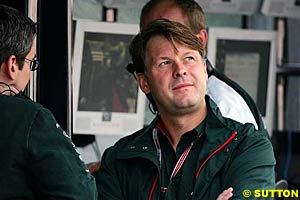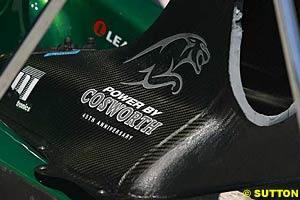Atlas F1 Magazine Writer
Fresh from the Formula One paddock
Abject sadness surrounds the death of any being, and so it is with the demise, certainly in their present forms, of Jaguar Racing and its cub, Cosworth Racing, but, really, their passing is not so much extinction as euthanasia, for both had, in the final analysis, shamed the great names of their progenitors and were, in their final forms, beyond saving.
Of course their passing has come as a shock to many in the insular world of Formula One where every truthful utterance is opposed by an opposite and equally strong denial, but the biggest shock was not that Ford had decided to chuck its twins out with their bathwater; just that very few had actually seen it coming. Sadly, but accurately as it turns out, on 25 August this column predicted Ford's withdrawal, with all the dire consequences now apparent, after the Blue Oval's Budget Meeting in Dearborn on September 15.
Then, of course, just when Prost and Arrows were facing closure, their principals spoke of bright futures and larger budgets than ever before; just when bankruptcies loomed for Pacific and Simtek, mega-sponsors were said to be knocking doors down in desperate attempts to hook into F1's perceived riches...
Jordan and Minardi, of course, are known to be in dire danger, something the paddock has acknowledged for three or so years past. And, with the possible demise of Cosworth, their future is less assured than ever. But, Jaguar in danger? This is, after all, a great company with a strong motor racing heritage; one whose very image oozes British Racing Green, stitched Connelly hides and hand-selected walnut burrs; above all, a racing team chosen to carry Ford's flame like a halo. This was, 'twas said at the team's launch at Lord's in January 2000, the real deal; one which would see the team challenging for podiums that year, wins the following and the Championship every year thereafter. After all, it had just missed out on the hallowed '1' on its primary car in its first season after one Edmund Irvine, to be paid more than any single Ford board member, had narrowly missed out on the Championship, had it not?
That the Ulsterman had been granted his challenge (made possible through a gifted win in Germany) by Ferrari only after Michael Schumacher sat out six Grands Prix through a broken leg; that the only previous recording of 'Jaguar' in Formula One's history came in the 1950 Italian Grand Prix, when Sardinia's 52-year old Clemente Biondetti entered a private Jaguar-powered Ferrari to qualify 25th before retiring with a blown engine, not surprisingly, stayed unmentioned.
Come Jaguar's first race, it was somewhat evident that the team had its priorities slightly topsy-turvy: where top teams flew 100 personnel to Melbourne, the Green Team took 120, but where the general ratio of race team to marketing staff was 70:30, in Jaguar's instance it was well-nigh 30:70! Yes, 80 London-Melbourne return aircraft seats, Business Class at that, filled by marketing whizzes, with just 40 – mainly steerage – being granted to coal-facers. But, then, then-Ford President Jac Nasser, who agreed the purchase of Stewart Grand Prix from Sir Jackie before re-branding it in the hopes of eventually 'Seeing a Sea of Green at Silverstone', had cut his motor industry teeth in at the company's plant on the outskirts of Melbourne.
And, therein lay the rub: Jaguar Racing was not about racing or F1 or winning or championships, but about vanity dressed as 'marketing', and when product sales, not surprisingly, did not soar through the skies above each Grand Prix circuit, team principals were changed like blown light bulbs. In quick succession the outfit went through Neil Ressler – who replaced the cancer-stricken Paul Stewart, who replaced his father, who, in a great example of timing, declined the offer – Bobby Rahal, Niki Lauda, and Tony Purnell, whilst good solid henchmen such as Guenther Steiner (ex-Ford) and Nick Hayes (Cosworth) were also hung out. And, the more sales of XJs and S- and X-Types fell, the faster Jaguar Racing's front doors revolved and the more the team became destabilised.
A measure of Jaguar's performance is encapsulated in one simple statistic: in 2002, Grand Prix rookie Mark Webber, using second-hand Peugeot engines (re-badged 'Asiatech') cobbled into a Minardi, scored fifth upon his debut Grand Prix; in his subsequent two-year stint at Jaguar, the Australian has failed to equal that placing. Commenting on the decision to withdraw from F1 at all costs, Ford Vice-President Richard Parry-Jones said that there was "no compelling business case to continue the operation". Was there ever one in Jaguar Racing's case?
After Parry-Jones' comments, come the questions. If there "is no compelling business case to continue the operation", why, just why, would any entity purchase the team, for, inherent in his statement is criticism of F1, not the operation.
Who, for example, would buy Jaguar Racing without a guarantee that Cosworth, under any guise, will continue in business, for Ford has indicated it will close any or all three entities if no buyers emerge. Equally, what is the fate of Minardi, which is locked into a contract that may not materialise? Or Jordan, which, once talks between itself and Toyota had broken down, seemed set on reconciliation with Cosworth despite the fact that its contract with Ford of Europe's RS brand, which paid the engine bills, seemed set to end in any event?
But, just what would any buyer of Jaguar Racing receive upon completion of sale, even if engine supply were assured at reasonable or no cost? Right of participation in the 2005 FIA Formula One World Championship, yes, but with two slots of 12 already open – and the $48m bond being, according to FIA President Max Mosley, no discernible barrier to entry – is there sufficient motivation to follow the Spotted Tail?
There may well be a half-designed car which, though, may need reengineering should it not comply with (as yet to-be-confirmed) 2005 regulations. Then, the team's wind tunnel is hardly top-drawer, whilst Michelin, as existing tyre supplier, could, conceivably, charge 'commercial terms' for its products, particularly as no OE contracts would offset supply costs, as is presently the case with Ford group companies.
The fact that Red Bull magnate Dietrich Mateschitz, after years of deliberation, and the due diligence that epitomised the Austrian's entry into the lifestyle drinks market, walked away from Jaguar some months ago, indicates that there is little of value in purchasing a team for which Ford, in 1999, paid upwards of $100m, and has pumped five times that into it during its ownership.
This saga, though, is set to run, for in true F1 style, carrion birds are circling the still-warm carcass of the Cat, and not only for its assets.
To those to whom F1 and the World Rally Championship, Ford's withdrawal from which has had little attention paid to it in view of the drama surrounding Browns' Lane, have spiralled out of control, the demise of the Blue Oval's competition activities, which stretch back to the days of 'Enry himself, on 'business' grounds implies that both series are, indeed, too expensive. But, are they too costly, or just not, in their present formats, cost effective, particularly in the way Jaguar went about its racing?
Here's betting Jaguar (and Ford) will not stop advertising, nor cease automotive research and development. This implies that money is there, despite losses totalling $200m in the second quarter, or equal to Jaguar's entire 2004 F1 budget, and will merely be spent more selectively. F1 need to evolve cost-effectively, not merely cheaply, and Jaguar's action will act as wake-up call to all.
Those, though, who believe that F1's present difficulties are due to some inequitable revenue distribution system – with teams splitting 23% of revenues whilst SLEC retains the balance after expenses - will maintain that Jaguar would have remained in F1 had teams received larger cuts. But, it could, of course, have carved bigger revenues had it performed better.
Then there are the critics of the critics of the GPWC, who will point to Jaguar's withdrawal from F1 as proof of the instability and unpredictability of manufacturer involvement in F1. But, will the team's decision spell the end of the body as a negotiating platform? Not likely: nowhere is it a requirement of GPWC membership that a manufacturer needs to compete to have a vote, and, in any event, Ford has not ruled out future involvement in the highest echelons of the sport, merely at present in its Jaguar guise. It has, in any event, spent upwards of $500m that it would like to recover somehow, sometime.
The banks, locked in a legal dispute over control of Formula One, will of course, seize upon the situation – and the demise of Prost and Arrows at around the time they acquired their 75% holding in SLEC through the default of Kirch Media to whom they had lent billions – as proof of Bernie Ecclestone's inability to manage the sport. But, history will show that Jaguar Racing is just one of 117 entrants to have tried and left, for whatever reasons, the sport since the inception of the FIA Formula One World Championship in 1950. This points to 2,166 outfits per season – substantially more than the three (if Jaguar is, indeed, closed, not sold) to have folded in three years since Prost went to the wall, or five operations in the ten years since the Pacific/Simtek debacles.
The three-car factions will, in all probability, get their wishes, but, if the ballot-system to which all agreed when signing Concorde is enforced, it could well accelerate further difficulties for Jordan and Minardi whilst precipitating problems for, say, Sauber, for, unless the points system changes (again), the top three teams could lock out the top nine places at every Grand Prix.
And, forget not that, where Toyota presently has two cars in the lower third of the pack, it could well then have three – enough for the Japanese giant to withdraw, too. After all, if, as is rumoured, it funds its F1 programme out of interest on its cash-in-hand reserves, it is a small matter for it to view its involvement, large as it may seem to mortals, as a waste of petty cash.
Finally, much has been said about this (Jaguar's withdrawal) being the beginning of the end for manufacturers in F1. Some may go and some may stay, but, ultimately, a global sport attracting viewers by the hundreds of million every fortnight is far from dead, and will always attract serious racers. And, they will always make compelling cases for moving the sport forward, even if they do so kicking and screaming.

 Of course, between the two dates, Jaguar Racing's MD, David Pitchforth, suggested an increased budget for 2005 had been approved, that driver decisions would be taken after 'Buttongate' (as though Mark Webber would about-turn should Jenson be confirmed at Williams, or sign for Jaguar should the Contract Recognition Board find that BAR holds a valid contract over the Brit), whilst Team Principal Tony Purnell implied his opponents would be jealous should they discover just what he had lined up for next season.
Of course, between the two dates, Jaguar Racing's MD, David Pitchforth, suggested an increased budget for 2005 had been approved, that driver decisions would be taken after 'Buttongate' (as though Mark Webber would about-turn should Jenson be confirmed at Williams, or sign for Jaguar should the Contract Recognition Board find that BAR holds a valid contract over the Brit), whilst Team Principal Tony Purnell implied his opponents would be jealous should they discover just what he had lined up for next season.

 Five years ago, when Volkswagen purchased the Cosworth Engineering, the production division of the once-proud company which won 176 Grand Prix in 480 starts to end 1999 to hold a better start: win strike rate than even Ferrari's engines, it discarded all thoughts of acquiring Cosworth Racing. Instead it did deals with Lamborghini and Bugatti, which, on the one hand, speaks volumes for VW's astuteness, whilst questioning it on the other.
Five years ago, when Volkswagen purchased the Cosworth Engineering, the production division of the once-proud company which won 176 Grand Prix in 480 starts to end 1999 to hold a better start: win strike rate than even Ferrari's engines, it discarded all thoughts of acquiring Cosworth Racing. Instead it did deals with Lamborghini and Bugatti, which, on the one hand, speaks volumes for VW's astuteness, whilst questioning it on the other.
|
Contact the Author Contact the Editor |
Please Contact Us for permission to republish this or any other material from Atlas F1.
|
Volume 10, Issue 38
Atlas F1 Special
Jaguar: All Out of Lives
Last to Know, First to Go
The Tarnished Mascot
Articles
The Gold Rush
Revved Up: Q&A with Shoichi Tanaka
Every Other Sunday
2004 Chinese GP Preview
2004 Chinese GP Preview
Chinese GP Facts & Stats
Columns
The F1 Trivia Quiz
Bookworm Critique
On the Road
Elsewhere in Racing
The Weekly Grapevine
> Homepage |
